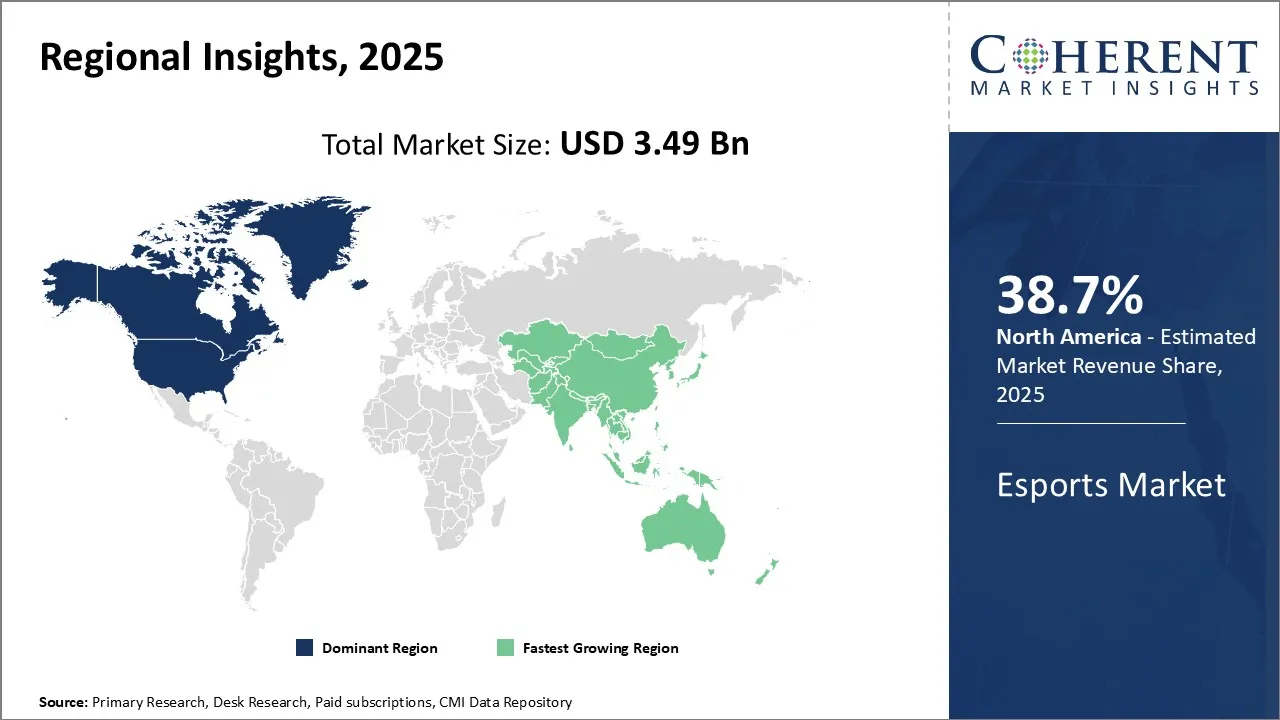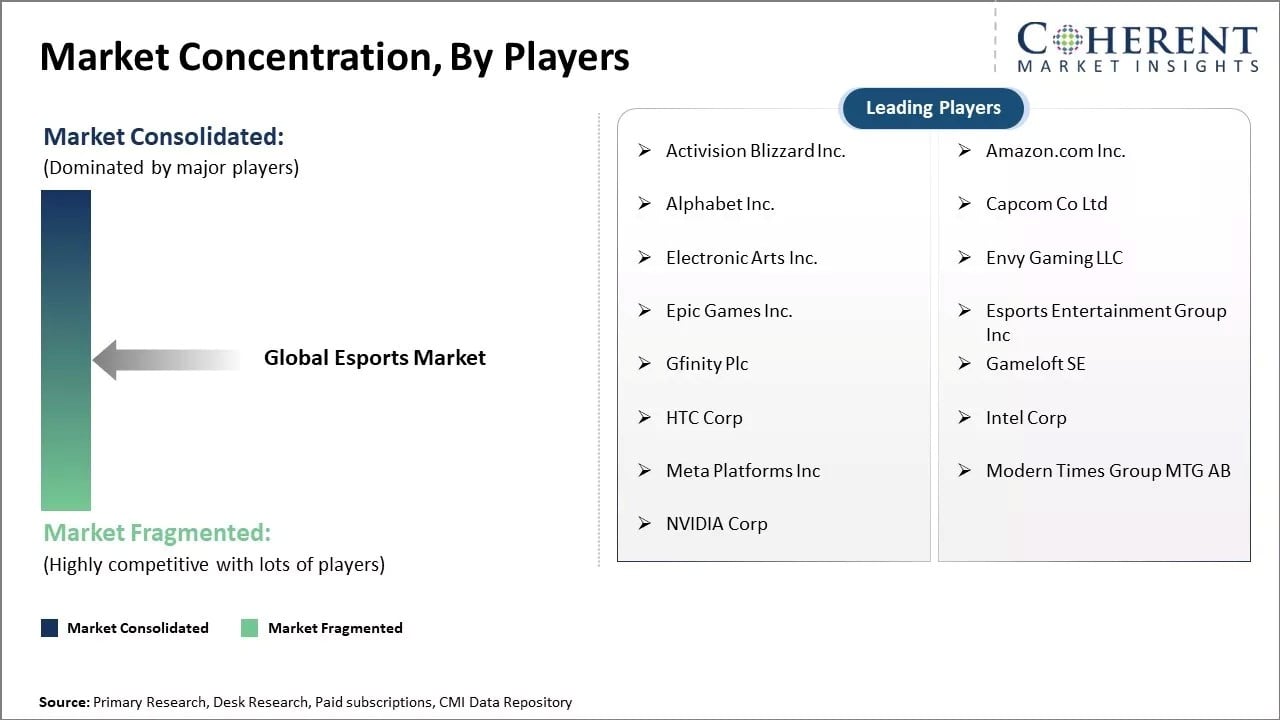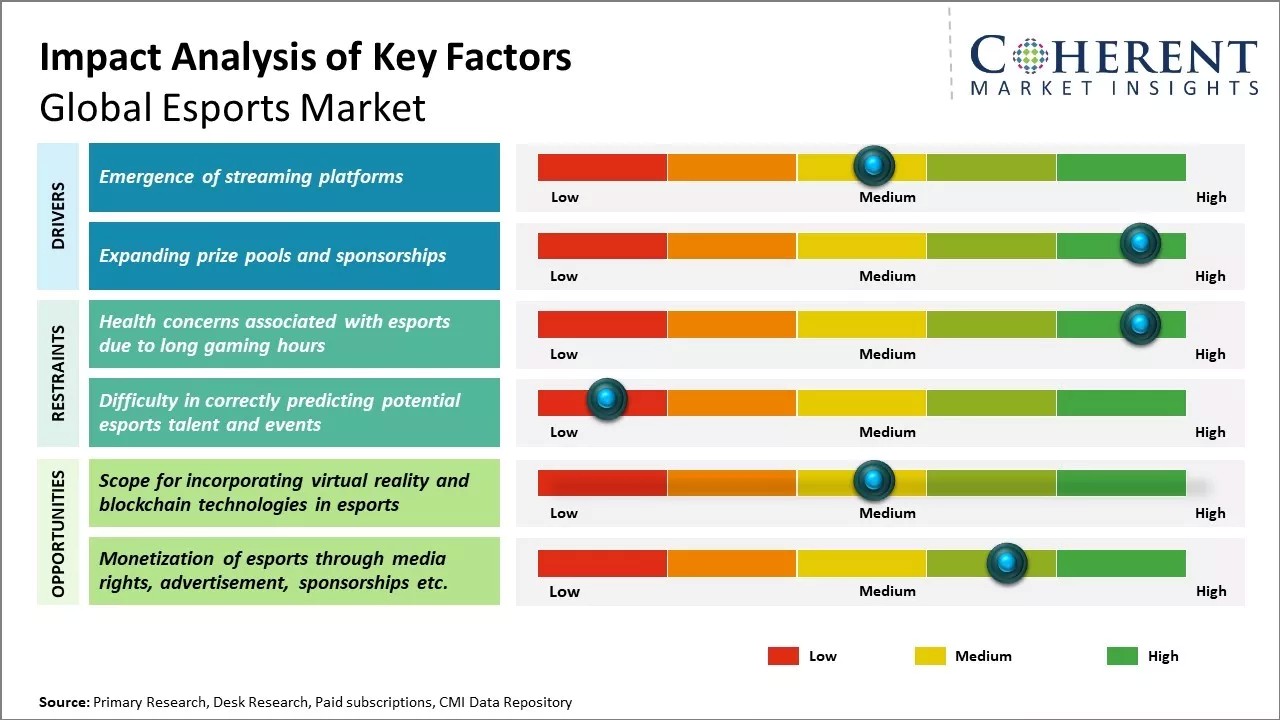The global esports market size is expected to exhibit a compound annual growth rate (CAGR) of 21.2% during the forecast, reaching USD 13.42 Bn by 2032, up from USD 3.49 Bn in 2025.
The esports market is expected to record robust growth during the forecast period. This can be attributed to factors like increasing interest in video games and growing popularity of esports competitions viewed as entertainment.
Live video streaming platforms and sponsorships from major brands and companies are also accelerating market revenues. Growing Millennials and GenZ population who are natives to gaming and technology, along with rising internet and smartphone penetration globally, are expected to push the market revenues upwards in the coming years.
Major online streaming platforms are investing heavily in tournaments and league championships. If this trend continues, the esports industry is poised to become one of the most popular forms of entertainment globally.
Major deals and partnerships are taking place in the esports industry. For instance, in May 2025, Team Vitality acquired Bigetron Esports, giving Vitality access to mobile titles like MLBB, PUBG Mobile, and Free Fire, and ~7 million followers across regional social platforms.
|
Current Event |
Description and its Impact |
|
Generative AI and Gaming Technology Integration |
|
|
Mobile Gaming Dominance in Emerging Markets |
|
Uncover macros and micros vetted on 75+ parameters: Get instant access to report
Media rights segment is expected to dominate the global esports market, accounting for a share of 34.9% in 2025. This can be attributed to the rising popularity of esports viewership on online streaming platforms.
Top-tier tournaments and leagues featuring prolific teams and players have been able to attract large audiences who tune in via live streaming to catch the action. This has made media rights very valuable for broadcasters and streaming services.
As esports becomes more popular around the world, more people are watching tournaments and leagues. Because of this, big esports organizations can charge higher fees for showing their events on TV or online. Games like DOTA 2, League of Legends, CS: GO, and Overwatch often get millions of viewers during major events, which increases the demand for media rights.
Top streaming platforms offer lucrative broadcast deals and exclusive streaming contracts for premium inventory, fueling high revenues. Regional expansion of tournaments and viewership growth have opened new opportunities as well.
Cultural influences and dedicated fan followings in Asia Pacific and other scenes provide greater potential for media companies. Localization of broadcasts through commentary and production value addition helps boost engagement further.
The evolution of high-quality immersive co-streaming options is also augmenting how fans experience and drive interest in esports media consumption. With esports becoming a major part of popular culture, media rights continue to grow as a key revenue driver.
Digital formats make it easy to reach wider audiences, boosting demand for high-value broadcast deals. As viewership expands, media rights are expected to remain a dominant force in esports monetization.

To learn more about this report, Download Free Sample
North America is the leader in esports, and this is expected to continue in the coming years. In 2025, the region is likely to make up 38.7% of the global esports market. The United States, especially, hosts many major professional esports leagues and tournaments.
North America also has some of the biggest gaming companies, such as Activision Blizzard and Take-Two Interactive. Because of this strong presence, the region has an advantage in creating gaming content and building esports infrastructure.
Collegiate esports programs are also growing rapidly across American universities, helping cultivate new talent as well as wider audience engagement. With strong corporate sponsorship and investment pouring in, North American teams have traditionally dominated international competitions. The size and sophistication of the regional streaming and live event industry further cement North America's leadership in modern esports.
Asia Pacific is emerging as a highly lucrative market for esports market companies. Countries like China, South Korea, and Japan have very vibrant domestic esports cultures with sizable endemic audiences. Traditional sports like fighting games have found new enthusiasts transitioning to competitive gaming.
Grassroots esports organizations covering multiple cities have helped professionalize the space, aided by increasing internet speeds as well as affordability of devices across Southeast Asia. Local game developers also tailor experiences for regional preferences, providing specialized content.
Rising income levels are bringing in new audiences and spend categories beyond hardware, streaming, and live events. With continued economic expansion and mainstream acceptance, Asia Pacific will play a crucial role shaping the future of esports on the global stage during the forthcoming period.
The U.S. esports market is poised to exhibit robust growth during the assessment period. This is mostly due to rising investments from major gaming publishers, tech companies, and media networks.
Growing popularity of competitive gaming leagues, along with increasing sponsorship deals from brands in technology, sportswear, and consumer goods, is further pushing market expansion. Similarly, the nation’s well-established internet infrastructure and high adoption of gaming consoles as well as PCs continue to support industry growth.
Another key driver is the rising consumer demand for digital entertainment and streaming content. Platforms such as Twitch and YouTube Gaming are attracting millions of viewers, making Esports one of the fastest-growing content categories.
China is emerging as one of the fastest-growing esports markets globally. This is mostly due to its massive base of young gamers and widespread access to mobile devices. Strong presence of leading gaming companies, such as Tencent and NetEase, continues to accelerate esports production, publishing, and tournament development.
The government is supporting digital entertainment, and more special esports venues are opening across the country. This is helping the market grow quickly. Another important trend in China’s esports sector is the growing popularity of mobile esports. Many people take part in mobile gaming because it is easy to access and does not require expensive equipment.
Live-streaming platforms like Douyu and Huya are also fueling audience growth by broadcasting tournaments and offering interactive features. With increasing investment in professional leagues and training facilities, China is expected to offer lucrative opportunities to esports companies during the forecast period.

To learn more about this report, Download Free Sample
| Report Coverage | Details | ||
|---|---|---|---|
| Base Year: | 2024 | Market Size in 2025: | USD 3.49 Bn |
| Historical Data for: | 2020 To 2024 | Forecast Period: | 2025 To 2032 |
| Forecast Period 2025 to 2032 CAGR: | 21.2% | 2032 Value Projection: | USD 13.42 Bn |
| Geographies covered: |
|
||
| Segments covered: |
|
||
| Companies covered: |
Activision Blizzard Inc., Amazon.com Inc., Alphabet Inc., Capcom Co Ltd, Electronic Arts Inc., Envy Gaming LLC, Epic Games Inc., Esports Entertainment Group Inc., Gfinity Plc, Gameloft SE, HTC Corp, Intel Corp, Meta Platforms Inc., Modern Times Group MTG AB, and NVIDIA Corp |
||
| Growth Drivers: |
|
||
| Restraints & Challenges: |
|
||
Uncover macros and micros vetted on 75+ parameters: Get instant access to report

To learn more about this report, Download Free Sample
The emergence and steady rise of new streaming platforms have been a major driver for the growth of the global esports market. Various video streaming services, such as Twitch, YouTube, Facebook Gaming, and others, have come up in the last few years, which have made esports streaming and viewing widely accessible. These platforms allow both amateurs and professional players to stream their gameplay and tournaments live for anyone to watch for free or through paid subscriptions.
Viewers around the world can now easily tune into their favorite esports’ athletes and events without any geographical restrictions. This has helped tremendously in popularizing esports on a global scale. More viewers are getting exposed to esports through live streaming, and it is generating a lot of interest among young populations who want to try their skills in gaming as well.
It has given professional players a way to monetize their skills and talents through subscriptions, donations, and advertisement revenues on these platforms. Leagues and tournament organizers are also leveraging streaming to broadcast all the action live for virtual audiences and generate greater revenues through sponsorship deals.
Overall, video streaming services have become the leading distribution platform and primary window for esports viewership worldwide. Their round-the-clock availability, coupled with high-quality production value, is translating viewers into die-hard esports fans, leading to sustained market growth.
The unprecedented rise in prize pools and monetary support from sponsors is another leading driver propelling the global esports industry forward at a rapid pace. Mega esports tournaments like The International Dota 2 Championships and League of Legends World Championships now feature prize pools exceeding tens of millions of dollars each year, crowdfunded entirely by fans.
Such astronomically high prize pools have elevated esports to another level in terms of legitimacy, prestige, and attraction for top tier pro-gamers. They are lured towards grinding long hours of practice and tournament participation as winning a single championship can potentially set them up financially for life.
Alongside, blue-chip companies from diverse industries like automobiles, consumer electronics, beverages, etc. are aggressively pumping millions of dollars in multi-year sponsorship deals with esports leagues, teams and events. They view esports as the ideal platform to reach younger, digitally savvy demographics in a highly engaging format. Sponsors are also getting exceptional returns through long term brand engagement, increased sales, and dedicated fan following generated through their involvement.
Esports has seen tremendous growth in recent years and has emerged as a billion-dollar global industry. With increasing popularity among both spectators and participants, especially among the younger generations, the esports market is poised to further expand in the coming years. Virtual reality and Blockchain technologies can play a pivotal role in propelling this growth trajectory.
Virtual Reality offers the ability to immerse viewers in the gameplay like never before. It can provide a first-person perspective and match the experience of being in the virtual field. This would take spectating engagement to an all-new interactive level. Players can also leverage VR for sophisticated training and skill development.
On the other hand, Blockchain can help address various challenges related to fraud, payments, and ownership rights. It allows creation of unique digital assets and proof of ownership through non-fungible tokens (NFTs). This opens up new revenue streams through asset monetization, sponsorships, and secondary markets. It brings transparency to results, rankings, and payments to players.
One of the major factors restraining growth of esports market is the rising health concerns due to long gaming hours. Playing games competitively at professional level requires extensive practice for several hours daily which can potentially harm the health of players both physically and mentally.
Esports players have to train their bodies and mind through repetitive intensive training, just like conventional athletes, which puts immense strain on them. Long working hours in front of displays coupled with lack of physical activity can increase the risks of health issues like obesity, diabetes, cardiovascular diseases, muscle and skeletal problems, eyestrain, and fatigue in players.
Prolonged gaming also poses severe mental health risks like depression, anxiety, cognitive impairments, addiction, and social isolation in esports athletes. The high stress and pressure to perform in tournaments can negatively impact their psychological well-being.
Share
Share
About Author
Ankur Rai is a Research Consultant with over 5 years of experience in handling consulting and syndicated reports across diverse sectors. He manages consulting and market research projects centered on go-to-market strategy, opportunity analysis, competitive landscape, and market size estimation and forecasting. He also advises clients on identifying and targeting absolute opportunities to penetrate untapped markets.
Missing comfort of reading report in your local language? Find your preferred language :
Transform your Strategy with Exclusive Trending Reports :
Frequently Asked Questions
Joining thousands of companies around the world committed to making the Excellent Business Solutions.
View All Our Clients